Numbers, Please: Power- and Voltage-Related Indices in Control of a Turbine-Generator Set
Abstract
1. Introduction
1.1. Preliminaries
1.2. Electrical Power Quality
Any power problem manifested in voltage, current, or frequency deviations that results in failure or misoperation of customer equipment.
The index that can quantify the behavior of the power system assessing the scale of power problems manifested in voltage, current, or frequency and that can be used for control system synthesis and evaluation.
2. Problem Description
- Overshoot—the largest, transient, deviation from the voltage set point;
- Stabilization time—the time after which the error is smaller than a certain deviation ;
- Rise time—the time for the controlled variable to rise from 10% to 90% of its final value or rise rate.
- Standard deviation
- Amount and time of deviations greater than from the nominal frequency;
- Trumpet characteristicsmust be met by the control system and are the requirement to contain the frequency waveform inside the trumpet characteristic after a sudden load step change. The curve is described by a pair of Equations (2) and (3),and defines an envelope-like bound on the transients where:
- is a stabilization time of 15 min;
- the constant A defines the trumpet characteristic width factor depending on the size of the power disturbance and the characteristics of the power system.
- is a share of the regulatory area in energy production,
- denotes the power frequency equivalent defining the change in power in for a change in frequency by determined for the entire system.
- ADI— Aggregated Data Index;
- FDI— Flagged Data Index.
- i is the number of the quality index;
- are the weights to balance all the components;
- are power quality parameters such as frequency change, voltage level, voltage variation, flicker severity, voltage unbalance, harmonic distortion and voltage change.
- f is the number of the 10 min period with disruptions,
- n is the number of all 10 min periods.
3. Model and Methods
- —active power;
- —reactive power;
- —generator’s voltage;
- —generator’s current;
- —generator’s angular speed;
- —excitation voltage;
- —Power system’s voltage;
- —Power system’s voltage frequency;
- p—steam pressure;
- —control valve opening;
- —steam vent valve opening for the heat generation;
- —mass flow of the steam for heat generation;
- —control valve opening.
3.1. Model Predictive Control
3.2. Methodology
- (a)
- Equalize the effect of factors on the overall result, as the power set point following error is of a much greater value (different order of magnitude) than the voltage amplitude and frequency fluctuations. Increasing the weights b and c allows taking the influence of these factors on the final result into account;
- (b)
- Distinguish between two contradictory tasks of the control system: following the active power set point and stabilizing the voltage amplitude and frequency. Due to internal interactions in the turbine-generator set, minimizing the power set point following error leads to the appearance of voltage amplitude oscillations. Therefore, further increasing b and c weights allows giving these components of the equation a dominant influence on the solution, i.e., to enhance the stabilizing effect of the system.
- Active power following;
- Balancing the components of the equation;
- Stabilization of the amplitude and the frequency.
4. Results and Discussion
- Best/worst based on ISE for weights’ set 1 (, , );
- Best/worst based on ITSE for weights’ set 1 (, , );
- Best/worst based on ISE for weights’ set 2 (, , );
- Best/worst based on ITSE for weights’ set 2 (, , );
- Best/worst based on ISE for weights’ set 3 (, , );
- Best/worst based on ITSE for weights’ set 3 (, , ).
- The best ISE for weights’ set A (, , );
- The best ISE for weights’ set D (, , );
- The best ISE for weights’ set G (, , ).
- The best ITSE for weights’ set B (, , );
- The best ITSE for weights’ set E (, , );
- The best ITSE for weights’ set H (, , ).
5. Conclusions
Author Contributions
Funding
Institutional Review Board Statement
Informed Consent Statement
Data Availability Statement
Conflicts of Interest
Nomenclature
| PS | Power system |
| PSS | Power system stabilizer |
| MPC | Model predictive control |
| DMC | Dynamic matrix control—a version of an MPC algorithm |
| RLS | Recursive least squares |
| DMPC | Distributed MPC |
| QDMC | Quadratic dynamic matrix control |
| QP | Quadratic programming |
| ISE | Integral of squared error |
| ITSE | Integral of time-weighted squared error |
| Active power | |
| RMS voltage | |
| Generator QDMC controller’s prediction horizon | |
| Turbine QDMC controller’s prediction horizon | |
| Angular speed | |
| THD | Total harmonic distortion |
Appendix A
| ISE | ||||||||
| 40 | 41 | 42 | 43 | 44 | 45 | 46 | 47 | |
| 10 | 2.43873 | 2.37898 | 2.43150 | 2.56877 | 2.70616 | 2.96770 | 3.23237 | 3.73933 |
| 11 | 2.04585 | 1.99423 | 2.03829 | 2.18294 | 2.33946 | 2.54966 | 2.82709 | 3.15873 |
| 12 | 1.07685 | 0.91385 | 1.61763 | 1.80037 | 1.98392 | 2.21408 | 2.44762 | 2.78032 |
| 13 | 0.96377 | 0.78082 | 0.67022 | 0.62197 | 1.63917 | 1.88155 | 2.16327 | 2.45595 |
| 14 | 0.94998 | 0.74087 | 0.61822 | 0.54716 | 0.51792 | 0.55053 | 1.84183 | 2.19676 |
| 15 | 0.94861 | 0.73070 | 0.59927 | 0.52067 | 0.47832 | 0.46732 | 0.50724 | 1.90370 |
| 16 | 0.94945 | 0.72881 | 0.58998 | 0.50670 | 0.46186 | 0.44323 | 0.45528 | 0.54513 |
| 17 | 0.95085 | 0.72875 | 0.58674 | 0.49890 | 0.45172 | 0.43083 | 0.43831 | 0.48706 |
| 18 | 0.95338 | 0.72995 | 0.58619 | 0.49559 | 0.44458 | 0.42307 | 0.42873 | 0.47208 |
| 19 | 0.95713 | 0.73203 | 0.58700 | 0.49403 | 0.44011 | 0.41734 | 0.42262 | 0.46456 |
| 20 | 0.96138 | 0.73463 | 0.58861 | 0.49416 | 0.43798 | 0.41373 | 0.41860 | 0.46040 |
| 21 | 0.96589 | 0.73750 | 0.59048 | 0.49511 | 0.43734 | 0.41165 | 0.41623 | 0.45844 |
| 22 | 0.97046 | 0.74038 | 0.59272 | 0.49673 | 0.43766 | 0.41074 | 0.41556 | 0.45826 |
| 23 | 0.97498 | 0.74348 | 0.59505 | 0.49866 | 0.43890 | 0.41119 | 0.41593 | 0.45957 |
| ITSE | ||||||||
| 40 | 41 | 42 | 43 | 44 | 45 | 46 | 47 | |
| 10 | 11.67213 | 12.72703 | 14.04284 | 15.67367 | 17.53902 | 19.46429 | 21.37105 | 23.79873 |
| 11 | 8.85470 | 9.68225 | 11.08334 | 12.85617 | 14.45448 | 16.28218 | 18.54309 | 21.00278 |
| 12 | 0.97977 | 0.73484 | 8.08074 | 9.95768 | 11.80484 | 13.79986 | 15.66905 | 18.17686 |
| 13 | 0.84906 | 0.51628 | 0.36496 | 0.31802 | 9.21858 | 11.33126 | 13.57128 | 15.66790 |
| 14 | 0.84480 | 0.49334 | 0.32117 | 0.23174 | 0.19770 | 0.32845 | 11.10305 | 13.71235 |
| 15 | 0.84617 | 0.49101 | 0.31290 | 0.21652 | 0.16481 | 0.14793 | 0.19247 | 11.47752 |
| 16 | 0.84885 | 0.49184 | 0.31092 | 0.21138 | 0.15646 | 0.13062 | 0.13313 | 0.36332 |
| 17 | 0.85180 | 0.49300 | 0.31084 | 0.20949 | 0.15272 | 0.12424 | 0.12014 | 0.15896 |
| 18 | 0.85651 | 0.49506 | 0.31177 | 0.20923 | 0.15067 | 0.11370 | 0.11424 | 0.14463 |
| 19 | 0.86347 | 0.49812 | 0.31333 | 0.20964 | 0.14991 | 0.11911 | 0.11088 | 0.13771 |
| 20 | 0.87117 | 0.50146 | 0.31513 | 0.21058 | 0.14986 | 0.11807 | 0.10848 | 0.13298 |
| 21 | 0.87921 | 0.50495 | 0.31713 | 0.21165 | 0.15023 | 0.11766 | 0.10705 | 0.12948 |
| 22 | 0.88738 | 0.50860 | 0.31911 | 0.21287 | 0.15085 | 0.11764 | 0.10635 | 0.12735 |
| 23 | 0.89559 | 0.51219 | 0.32115 | 0.21430 | 0.15172 | 0.11799 | 0.10619 | 0.12645 |
| ISE | ||||||||
| 40 | 41 | 42 | 43 | 44 | 45 | 46 | 47 | |
| 10 | 0.95698 | 0.74364 | 0.58884 | 0.48469 | 0.42488 | 0.36521 | 0.33680 | 0.32282 |
| 11 | 0.94770 | 0.73096 | 0.58715 | 0.48910 | 0.41952 | 0.37308 | 0.34469 | 0.33463 |
| 12 | 0.93025 | 0.70990 | 0.57914 | 0.48222 | 0.41367 | 0.36815 | 0.33901 | 0.32995 |
| 13 | 0.93823 | 0.71127 | 0.56211 | 0.46027 | 0.40763 | 0.36242 | 0.33453 | 0.32543 |
| 14 | 0.94051 | 0.71403 | 0.56326 | 0.45989 | 0.38713 | 0.33821 | 0.32891 | 0.32118 |
| 15 | 0.94161 | 0.71532 | 0.56434 | 0.46026 | 0.38679 | 0.33663 | 0.30440 | 0.31599 |
| 16 | 0.94311 | 0.71641 | 0.56543 | 0.46095 | 0.38688 | 0.33621 | 0.30315 | 0.29056 |
| 17 | 0.94461 | 0.71731 | 0.56612 | 0.46154 | 0.38717 | 0.33620 | 0.30244 | 0.28870 |
| 18 | 0.94701 | 0.71871 | 0.56702 | 0.46224 | 0.38766 | 0.33619 | 0.30213 | 0.28759 |
| 19 | 0.95051 | 0.72061 | 0.56822 | 0.46303 | 0.38825 | 0.33638 | 0.30192 | 0.28678 |
| 20 | 0.95441 | 0.72281 | 0.56962 | 0.46393 | 0.38885 | 0.33678 | 0.30172 | 0.28598 |
| 21 | 0.95851 | 0.72511 | 0.57092 | 0.46473 | 0.38945 | 0.33718 | 0.30182 | 0.28528 |
| 22 | 0.96261 | 0.72731 | 0.57232 | 0.46563 | 0.38995 | 0.33757 | 0.30191 | 0.28478 |
| 23 | 0.96661 | 0.72961 | 0.57362 | 0.46643 | 0.39045 | 0.33797 | 0.30211 | 0.28468 |
| ITSE | ||||||||
| 40 | 41 | 42 | 43 | 44 | 45 | 46 | 47 | |
| 10 | 1.06062 | 0.72651 | 0.55370 | 0.46602 | 0.43153 | 0.40868 | 0.40519 | 0.42899 |
| 11 | 0.99157 | 0.65903 | 0.50139 | 0.42564 | 0.38488 | 0.37313 | 0.38318 | 0.41791 |
| 12 | 0.82096 | 0.47876 | 0.44205 | 0.37449 | 0.34277 | 0.33838 | 0.34654 | 0.38911 |
| 13 | 0.83651 | 0.47944 | 0.29917 | 0.19812 | 0.29713 | 0.29755 | 0.31687 | 0.35783 |
| 14 | 0.84021 | 0.48341 | 0.30072 | 0.19733 | 0.13586 | 0.10353 | 0.27644 | 0.33050 |
| 15 | 0.84210 | 0.48511 | 0.30191 | 0.19782 | 0.13543 | 0.09967 | 0.08423 | 0.29370 |
| 16 | 0.84470 | 0.48651 | 0.30311 | 0.19851 | 0.13557 | 0.09921 | 0.08237 | 0.09652 |
| 17 | 0.84740 | 0.48761 | 0.30381 | 0.19911 | 0.13592 | 0.09919 | 0.08137 | 0.09113 |
| 18 | 0.85181 | 0.48941 | 0.30481 | 0.19971 | 0.13631 | 0.09172 | 0.08096 | 0.08899 |
| 19 | 0.85841 | 0.49210 | 0.30611 | 0.20041 | 0.13681 | 0.09935 | 0.08060 | 0.08740 |
| 20 | 0.86571 | 0.49501 | 0.30751 | 0.20121 | 0.13721 | 0.09962 | 0.08020 | 0.08576 |
| 21 | 0.87331 | 0.49801 | 0.30901 | 0.20191 | 0.13761 | 0.09990 | 0.08010 | 0.08416 |
| 22 | 0.88101 | 0.50111 | 0.31041 | 0.20261 | 0.13801 | 0.10012 | 0.07995 | 0.08304 |
| 23 | 0.88871 | 0.50411 | 0.31181 | 0.20341 | 0.13841 | 0.10032 | 0.07996 | 0.08250 |
| ISE | ||||||||
| 40 | 41 | 42 | 43 | 44 | 45 | 46 | 47 | |
| 10 | 1.49278 | 1.64440 | 1.85037 | 2.09099 | 2.28779 | 2.60873 | 2.90181 | 3.42312 |
| 11 | 1.10871 | 1.27183 | 1.45845 | 1.70042 | 1.92604 | 2.18247 | 2.48832 | 2.83025 |
| 12 | 0.15605 | 0.21124 | 1.04531 | 1.32428 | 1.57594 | 1.851440 | 2.11409 | 2.45610 |
| 13 | 0.03495 | 0.07673 | 0.11384 | 0.16647 | 1.23683 | 1.52425 | 1.83389 | 2.13588 |
| 14 | 0.01888 | 0.03401 | 0.06065 | 0.09195 | 0.13479 | 0.21591 | 1.51770 | 1.88065 |
| 15 | 0.01643 | 0.02255 | 0.04062 | 0.06507 | 0.09549 | 0.13418 | 0.20608 | 1.59244 |
| 16 | 0.01579 | 0.01957 | 0.03023 | 0.05041 | 0.07893 | 0.11049 | 0.15531 | 0.25773 |
| 17 | 0.01570 | 0.01862 | 0.02630 | 0.04202 | 0.06850 | 0.09809 | 0.13903 | 0.20145 |
| 18 | 0.01585 | 0.01844 | 0.02486 | 0.03801 | 0.06086 | 0.09033 | 0.12975 | 0.18755 |
| 19 | 0.01614 | 0.01863 | 0.02448 | 0.03566 | 0.05579 | 0.08440 | 0.12384 | 0.18083 |
| 20 | 0.01652 | 0.01906 | 0.02470 | 0.03490 | 0.05307 | 0.08040 | 0.12001 | 0.17746 |
| 21 | 0.01697 | 0.01965 | 0.02529 | 0.03506 | 0.05184 | 0.07792 | 0.11754 | 0.17619 |
| 22 | 0.01749 | 0.02035 | 0.02614 | 0.03578 | 0.05166 | 0.07662 | 0.11678 | 0.17651 |
| 23 | 0.01805 | 0.02118 | 0.02720 | 0.03692 | 0.05241 | 0.07666 | 0.11695 | 0.17792 |
| ITSE | ||||||||
| 40 | 41 | 42 | 43 | 44 | 45 | 46 | 47 | |
| 10 | 10.63263 | 12.01967 | 13.50804 | 15.22738 | 17.12876 | 19.07859 | 20.99069 | 23.39719 |
| 11 | 7.88084 | 9.0388 | 10.59745 | 12.44710 | 14.08739 | 15.92855 | 18.1817 | 20.60945 |
| 12 | 0.16717 | 0.26113 | 7.65069 | 9.59643 | 11.47685 | 13.47821 | 15.34116 | 17.80927 |
| 13 | 0.02092 | 0.04168 | 0.06885 | 0.12200 | 8.93326 | 11.04763 | 13.27071 | 15.32883 |
| 14 | 0.01300 | 0.01478 | 0.02348 | 0.03641 | 0.06326 | 0.22619 | 10.84011 | 13.39842 |
| 15 | 0.01249 | 0.01076 | 0.01402 | 0.02070 | 0.03077 | 0.04931 | 0.10919 | 11.19785 |
| 16 | 0.01260 | 0.01020 | 0.01085 | 0.01487 | 0.02227 | 0.03243 | 0.05163 | 0.26803 |
| 17 | 0.01287 | 0.01028 | 0.01007 | 0.01238 | 0.01818 | 0.02607 | 0.03962 | 0.06881 |
| 18 | 0.01323 | 0.01055 | 0.01002 | 0.01153 | 0.01573 | 0.02292 | 0.03412 | 0.05659 |
| 19 | 0.01366 | 0.01094 | 0.01029 | 0.01124 | 0.01448 | 0.02077 | 0.03111 | 0.05123 |
| 20 | 0.01413 | 0.01141 | 0.01070 | 0.01138 | 0.01403 | 0.01946 | 0.02911 | 0.04813 |
| 21 | 0.01464 | 0.01193 | 0.01122 | 0.01176 | 0.01401 | 0.01878 | 0.02782 | 0.04621 |
| 22 | 0.01519 | 0.01251 | 0.01181 | 0.01229 | 0.01423 | 0.01854 | 0.02723 | 0.04518 |
| 23 | 0.01578 | 0.01313 | 0.01247 | 0.01294 | 0.01471 | 0.01870 | 0.02706 | 0.04482 |
References
- Energy Policy of Poland until 2040. Available online: https://www.gov.pl/web/klimat/polityka-energetyczna-polski (accessed on 4 January 2022).
- Polskie Elektrownie Jądrowe sp. z o.o. (Polish Nuclear Power Plants). Available online: https://ppej.pl (accessed on 9 March 2022).
- Wurster, S.; Hagemann, C. Expansion of Renewable Energy in Federal Settings: Austria, Belgium, and Germany in Comparison. J. Environ. Dev. 2020, 29, 147–168. [Google Scholar] [CrossRef]
- Mešanović, A.; Münz, U.; Szabo, A.; Mangold, M.; Bamberger, J.; Metzger, M.; Heyde, C.; Krebs, R.; Findeisen, R. Structured controller parameter tuning for power systems. Control Eng. Pract. 2020, 101, 104490. [Google Scholar] [CrossRef]
- Sobbouhi, A.; Vahedi, A. Transient stability prediction of power system; A review on methods, classification and considerations. Electr. Power Syst. Res. 2020, 190, 106853. [Google Scholar] [CrossRef]
- Gündeş, A.; Özbay, H. Controller redesign for delay margin improvement. Automatica 2020, 113, 108790. [Google Scholar] [CrossRef]
- Zhang, B.; Tan, W.; Li, J. Tuning of linear active disturbance rejection controller with robustness specification. ISA Trans. 2019, 85, 237–246. [Google Scholar] [CrossRef] [PubMed]
- Fadali, M.; Visioli, A. Chapter 3—Modeling of digital control systems. In Digital Control Engineering, 3rd ed.; Academic Press: Cambridge, MA, USA, 2020; pp. 60–102. [Google Scholar] [CrossRef]
- Dorf, R.C.; Bishop, R.H. Modern Control Systems, 14th ed.; Pearson: London, UK, 2022. [Google Scholar]
- Passos, A.; Souza, R.C. Defining a quality index for electric power utilities using multiple criteria decision support and time series analysis. GestãO Produção 2013, 20, 1–13. [Google Scholar] [CrossRef]
- Fumagalli, E.; Schiavo, L. Regulating and improving the quality of electricity supply: The case of Italy. Eur. Rev. Energy Mark. 2009, 3, 1–27. [Google Scholar]
- Morsi, W.G.; El-Hawary, M.E. Novel power quality indices based on wavelet packet transform for non-stationary sinusoidal and non-sinusoidal disturbances. Electr. Power Syst. Res. 2009, 80, 753–759. [Google Scholar] [CrossRef]
- Thirumala, K.; Shanatu, T.; Jain, T.; Umarikar, A.C. Visualizing time-varying power quantity indices using generalized empirical wavelet transform. Electr. Power Syst. Res. 2017, 143, 99–109. [Google Scholar] [CrossRef]
- Kaddah, S.S.; Abo-Al-Ez, K.M.; Megahed, T.F.; Osman, M.G. Probabilistic power quality indices for electric grids with increased penetration level of wind power generation. Electr. Power Energy Syst. 2016, 77, 50–58. [Google Scholar] [CrossRef]
- Rodriguez-Pajaron, P.; Bayo, A.H.; Milanovic, J.V. Probabilistic assessment of the influence of transformer rating on power quality indices in future residual networks. Int. J. Electr. Power Energy Syst. 2021, 135, 107582. [Google Scholar] [CrossRef]
- Zhang, Y.; Zhang, Y.; Zhou, X. Classification of power quality disturbances using visual attention mechanism and feed-forward neural network. Measurement 2021, 188, 110390. [Google Scholar] [CrossRef]
- Tesarova, M. Power Quality and Quality of Supply; University of West Bohemia: Pilsen, Czech Republic, 2011. [Google Scholar]
- Raptis, T.; Vokas, G.; Langouranis, P.; Kaminaris, S. Total Power Quality Index for Electrical Networks Using Neural Networks. Energy Procedia 2015, 74, 1499–1507. [Google Scholar] [CrossRef]
- Jasiński, M.; Sikorski, T.; Kostyła, P.; Borkowski, K. Global power quality indices for assessment of multipoint Power quality measurements. In Proceedings of the Conference: 2018 10th International Conference on Electronics, Computers and Artificial Intelligence (ECAI), Iasi, Romania, 28–30 June 2018. [Google Scholar] [CrossRef]
- Dugan, R.; McGranaghan, M.; Santoso, S. Electrical Power Systems Quality; McGraw Hill: New York, NY, USA, 2012. [Google Scholar]
- Watson, N.; Miller, A. Power Quality Indices Power Quality Indices: A Review. In Proceedings of the Electricity Engineers’ Association Conference, Wellington, New Zealand, 24–26 June 2015. [Google Scholar]
- Instrukcja Ruchu i Ekspoatacji Sieci Przesyłowej; Polskie Sieci Elektroenergetyczne, 2006; Available online: https://www.gaz-system.pl/fileadmin/pliki/iriesp/pl/IRiESP_czI_26062006.pdf (accessed on 20 February 2022).
- Machowski, J. Regulacja Systemu Elektroenergetycznego; Oficyna Wydawnicza Politechniki Warszawskiej: Warszawa, Poland, 2017. [Google Scholar]
- Jasiński, M.; Sikorski, T.; Kaczorowska, D.N.; Rezmer, J.; Suresh, V.; Leonowicz, Z.; Kostyła, P.; Szymańda, J.; Janik, P. A case study on power quality in a virtual power plant: Long term assessment and global index application. Energies 2020, 13, 6578. [Google Scholar] [CrossRef]
- Jasiński, M.; Sikorski, T.; Kostyła, P.; Leonowicz, Z.; Borkowski, K. Combined cluster analysis and global power quality indices for the qualitative assessment of the time-varying condition of power quality in an electrical power network with distributed generation. Energies 2020, 13, 2050. [Google Scholar] [CrossRef]
- Sokólski, P.; Rutkowski, T.A.; Ceran, B.; Horla, D.; Złotecka, D. Power System Stabilizer as a Part of a Generator MPC Adaptive Predictive Control System. Energies 2020, 14, 6631. [Google Scholar] [CrossRef]
- Gallieri, M.; Maciejowski, J. Model predictive control with prioritised actuators. In Proceedings of the 2015 European Control Conference (ECC), Linz, Austria, 15–17 July 2015. [Google Scholar] [CrossRef]
- Camacho, E.; Alba, C. Model Predictive Control; Springer Science & Business Media: Berlin/Heidelberg, Germany, 2013. [Google Scholar]
- Jana, A.; Samanta, A.; Ganguly, S. Globally linearized control system design of a constrained multivariable distillation column. J. Process Control 2005, 15, 169–181. [Google Scholar] [CrossRef]
- Sokólski, P.; Rutkowski, T.; Duzinkiewicz, K. The distributed model predictive controller for the nuclear power plant turbo-generator set. In Proceedings of the 2017 22nd International Conference on Methods and Models in Automation and Robotics (MMAR), Miedzyzdroje, Poland, 28–31 August 2017. [Google Scholar]
- Power System Dynamic Performance Committee. Dynamic Models for Turbine–Governors in Power System Studies. IEEE Power Energy Soc. 2013. [Google Scholar]
- Loo, C.; Vanfretti, L.; Liceaga-Castro, E.; Acha, E.E. Synchronous Generators Modeling and Control Using the Framework of Individual Channel Analysis and Design: Part 1. Int. J. Emerg. Electr. Power Syst. 2007, 8, 1–26. [Google Scholar] [CrossRef]
- Sokolski, P.; Rutkowski, T.; Duzinkiewicz, K. Simplified, multiregional fuzzy model of a nuclear power plant steam turbine. In Proceedings of the 21ST International Conference on Methods and Models in Automation and Robotics (MMAR), Miedzyzdroje, Poland, 29 August–1 September 2016; pp. 379–384. [Google Scholar]
- Imieliński, A. Mathematical Model of Synchronous Generator for Full-Scope Simulator; Gdañsk University of Technology, Faculty of Electrical and Control Engineering: Gdańsk, Poland, 1987; unpublished. [Google Scholar]
- Wojtulewicz, A. Implementation of Dynamic Matrix Control Algorithm Using Field Programmable Gate Array: Preliminary Results. In Trends in Advanced Intelligent Control, Optimization and Automation; Springer: Cham, Switzerland, 2017. [Google Scholar]
- Wojtulewicz, A. Implementation of DMC algorithm in embedded controller—Resources, memory and numerical modifications. In Trends in Advanced Intelligent Control, Optimization and Automation; Springer: Cham, Switzerland, 2017. [Google Scholar]
- Chaber, P.; Ławryńczuk, M. Implementation of Analytical Generalized Predictive Controller for Very Fast Applications Using Microcontrollers: Preliminary Results. In Trends in Advanced Intelligent Control, Optimization and Automation; Springer: Cham, Switzerland, 2017. [Google Scholar]
- Sokólski, P.; Rutkowski, T.A.; Duzinkiewicz, K. The QDMC Model Predictive Control. In Advances in Intelligent Systems and Computing; Springer: Cham, Switzerland, 2017. [Google Scholar]
- Sokólski, P.; Kobylarz, A.; Kulkowski, K.; Duzinkiewicz, K.; Rutkowski, T.; Grochowski, M. Advanced control structures of turbo generator system of nuclear power plant. Acta Energetica 2015, 3, 83–96. [Google Scholar] [CrossRef][Green Version]
- Sokolski, P.; Rutkowski, T.; Duzinkiewicz, K. The excitation controller with gain scheduling mechanism for synchronous generator control. In Proceedings of the 2015 20th International Conference on Methods and Models in Automation and Robotics (MMAR), Miedzyzdroje, Poland, 24–27 August 2015; pp. 23–28. [Google Scholar]

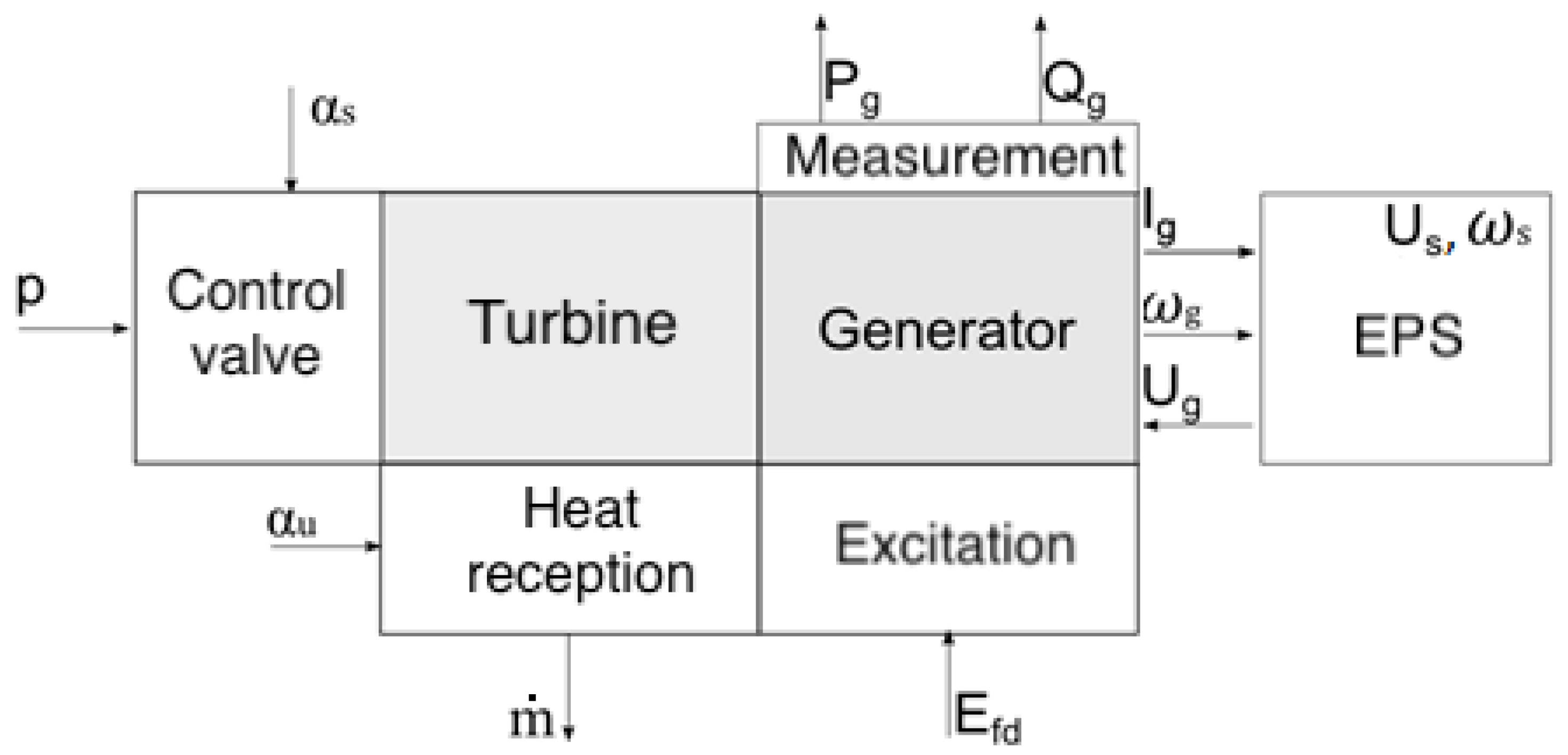



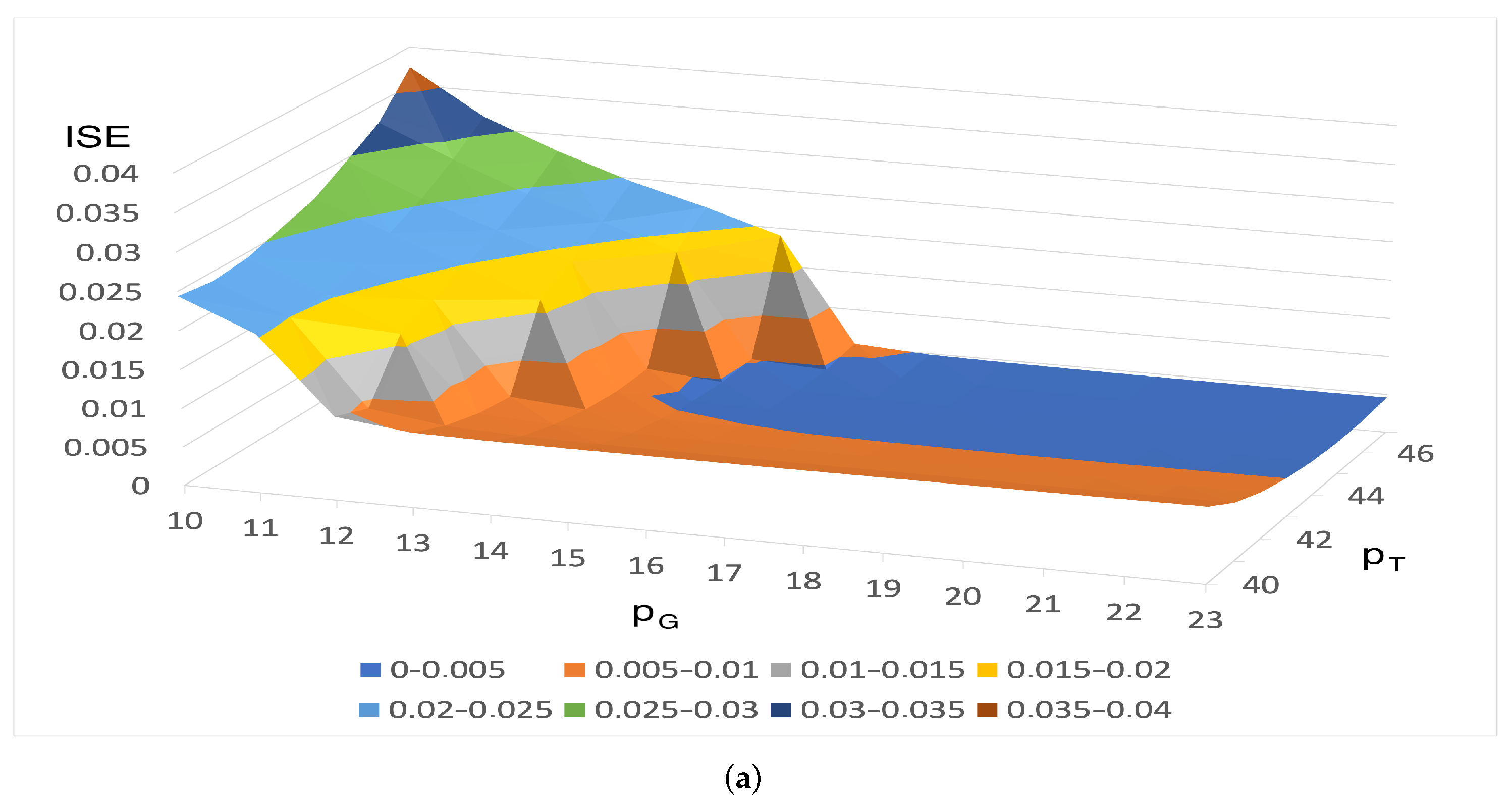
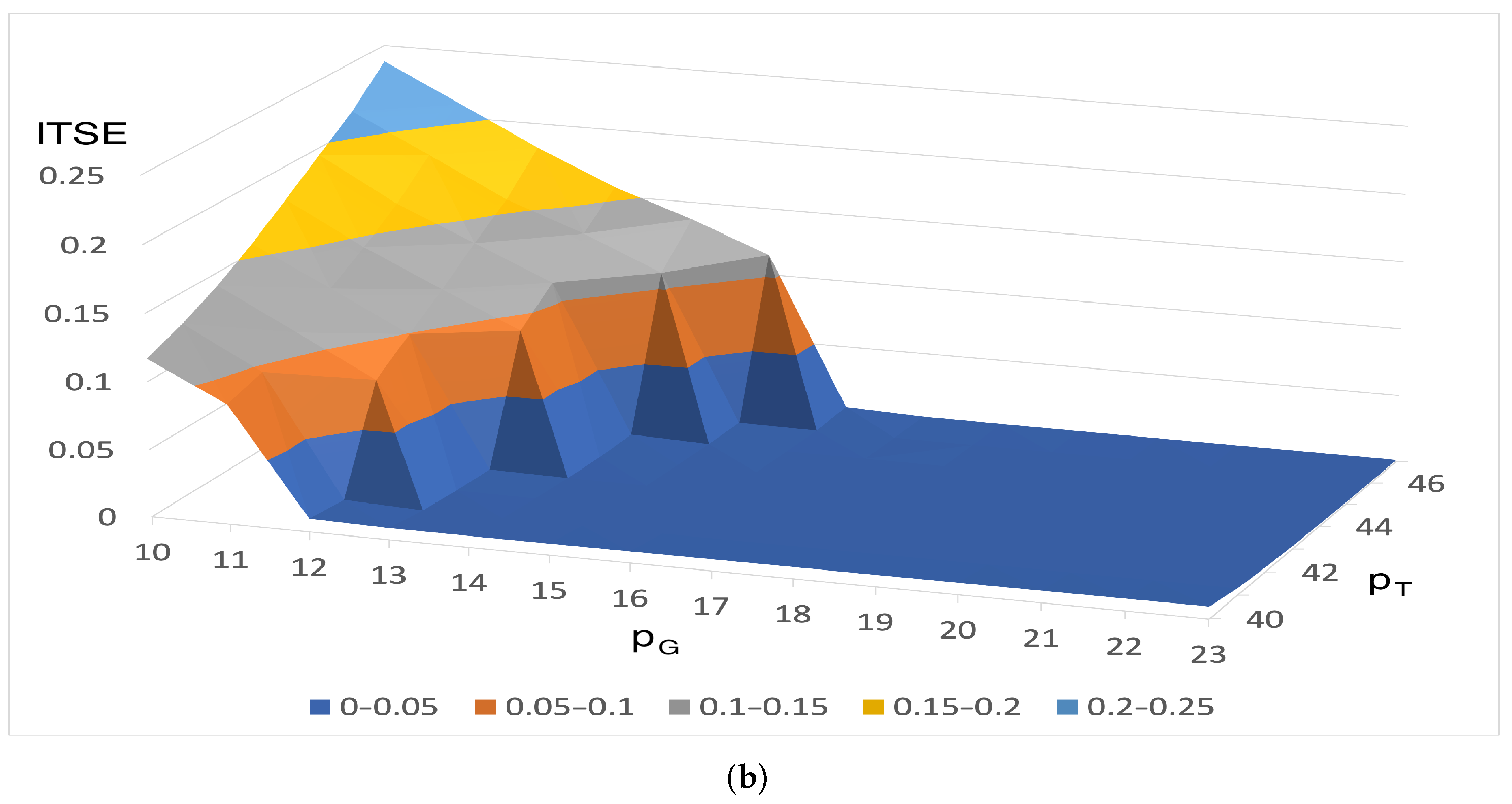


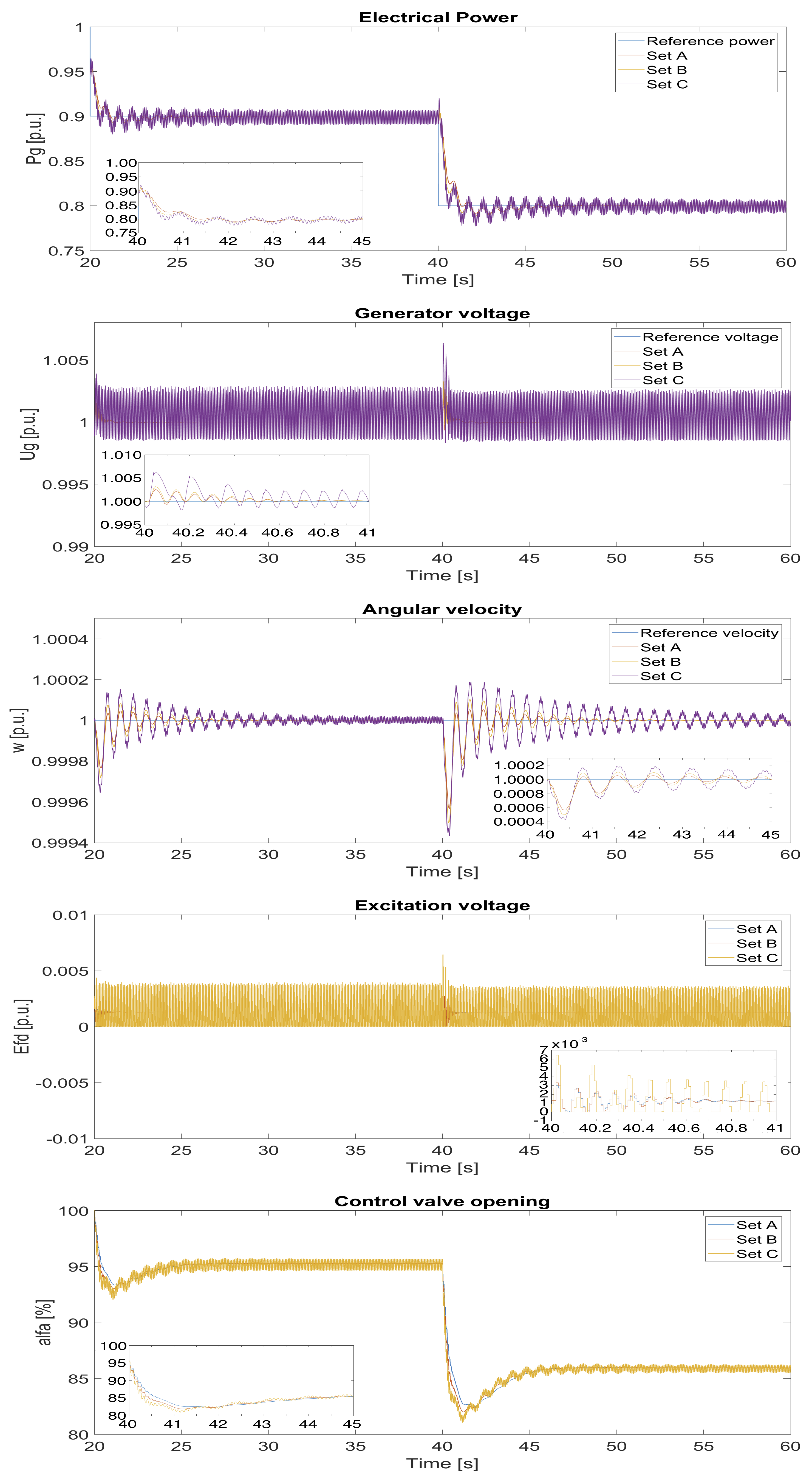


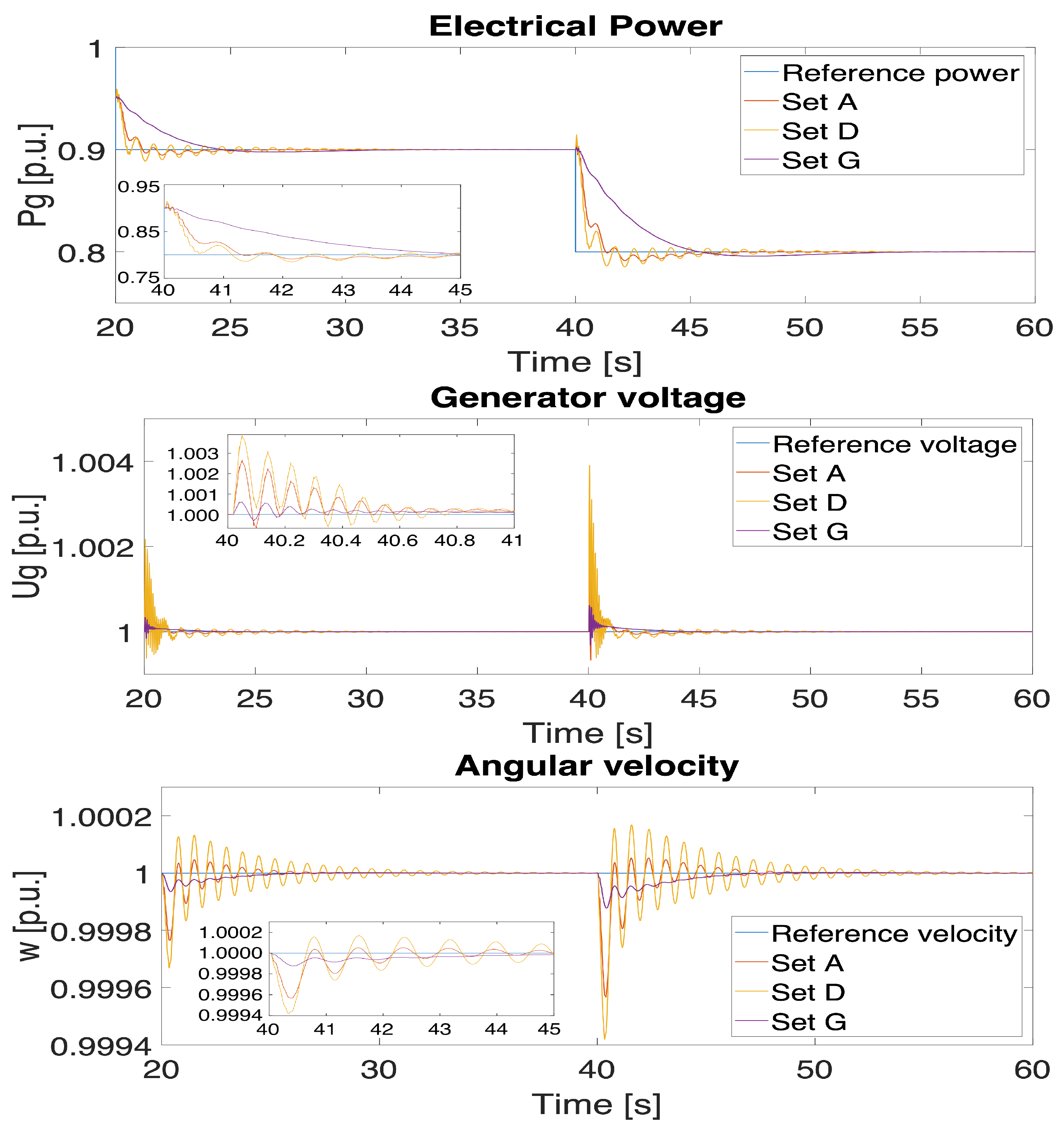
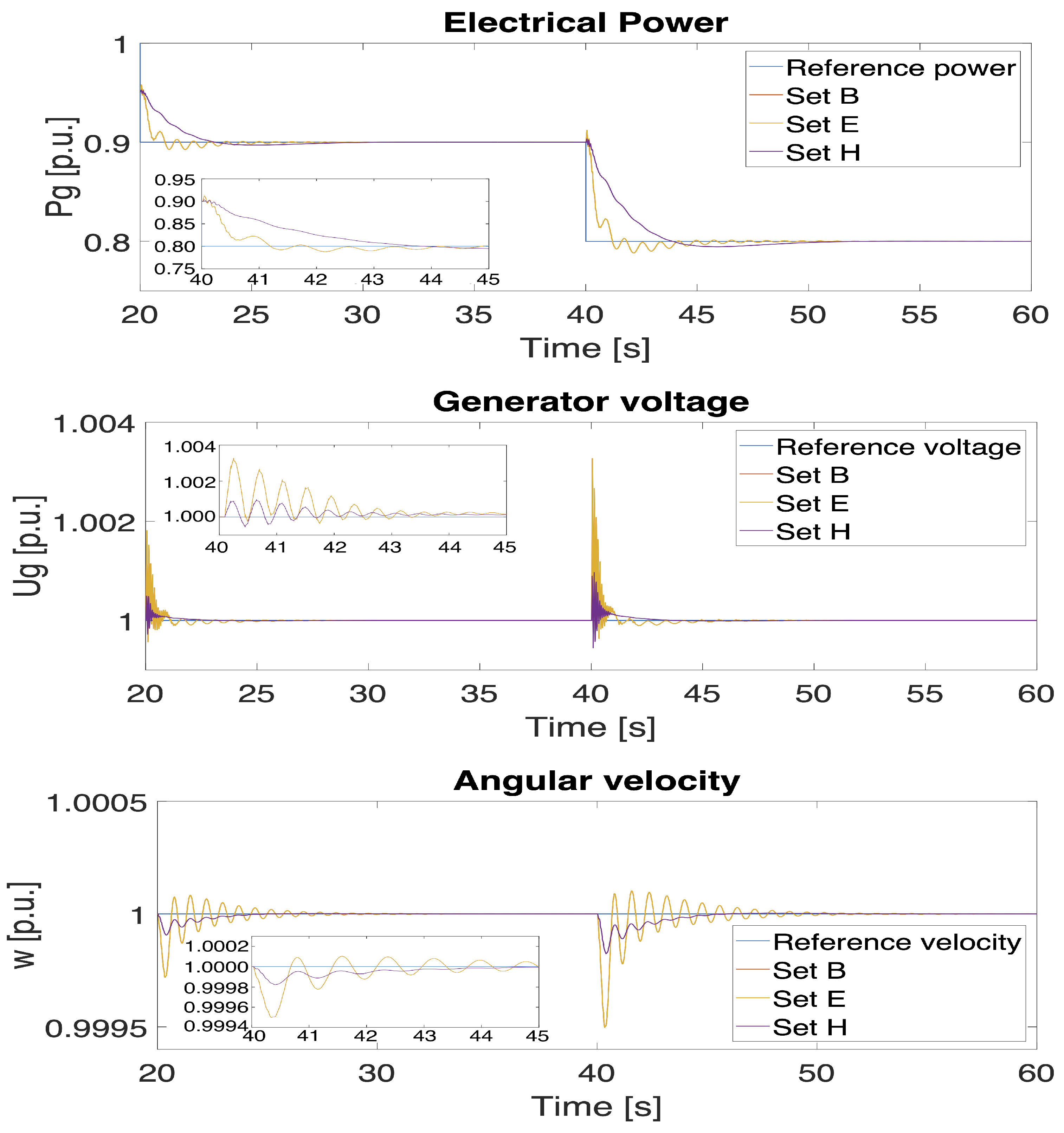
| Feature | Notation/Ranges | Explanation |
|---|---|---|
| outputs | power, voltage, frequency | |
| set values | reference power, | |
| constant set voltage | ||
| and frequency values | ||
| control signals | control valve opening, | |
| excitation voltage | ||
| constraints | , | minimum/maximum: |
| valve opening (0–100%), | ||
| excitation system voltage | ||
| ( |
| Set | a | b | c | Index | Value | Comment | pT | pG |
|---|---|---|---|---|---|---|---|---|
| A | 1 | 1000 | 1000 | ISE | 0.004107 | Best | 45 | 22 |
| B | 1 | 1000 | 1000 | ITSE | 0.00106 | Best | 46 | 23 |
| C | 1 | 1000 | 1000 | ISE/ITSE | 0.03739/0.23799 | Worst | 47 | 10 |
| D | 1 | 1 | 1 | ISE | 0.00285 | Best | 47 | 23 |
| E | 1 | 1 | 1 | ITSE | 0.0008 | Best | 46 | 23 |
| F | 1 | 1 | 1 | ISE/ITSE | 0.00975/0.01061 | Worst | 40 | 10 |
| G | 1 | 100,000 | 100,000 | ISE | 0.0157 | Best | 40 | 17 |
| H | 1 | 100,000 | 100,000 | ITSE | 0.010202 | Best | 41 | 16 |
| I | 1 | 100,000 | 100,000 | ISE/ITSE | 3.42312/23.3972 | Worst | 47 | 10 |
Publisher’s Note: MDPI stays neutral with regard to jurisdictional claims in published maps and institutional affiliations. |
© 2022 by the authors. Licensee MDPI, Basel, Switzerland. This article is an open access article distributed under the terms and conditions of the Creative Commons Attribution (CC BY) license (https://creativecommons.org/licenses/by/4.0/).
Share and Cite
Sokólski, P.; Rutkowski, T.A.; Ceran, B.; Złotecka, D.; Horla, D. Numbers, Please: Power- and Voltage-Related Indices in Control of a Turbine-Generator Set. Energies 2022, 15, 2453. https://doi.org/10.3390/en15072453
Sokólski P, Rutkowski TA, Ceran B, Złotecka D, Horla D. Numbers, Please: Power- and Voltage-Related Indices in Control of a Turbine-Generator Set. Energies. 2022; 15(7):2453. https://doi.org/10.3390/en15072453
Chicago/Turabian StyleSokólski, Paweł, Tomasz A. Rutkowski, Bartosz Ceran, Daria Złotecka, and Dariusz Horla. 2022. "Numbers, Please: Power- and Voltage-Related Indices in Control of a Turbine-Generator Set" Energies 15, no. 7: 2453. https://doi.org/10.3390/en15072453
APA StyleSokólski, P., Rutkowski, T. A., Ceran, B., Złotecka, D., & Horla, D. (2022). Numbers, Please: Power- and Voltage-Related Indices in Control of a Turbine-Generator Set. Energies, 15(7), 2453. https://doi.org/10.3390/en15072453








